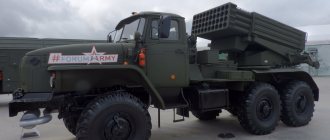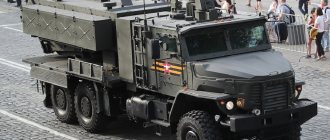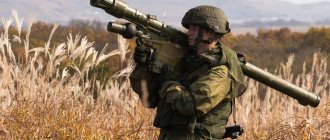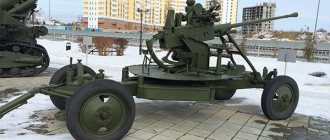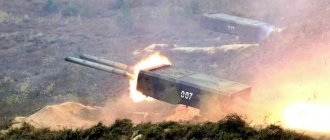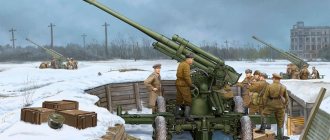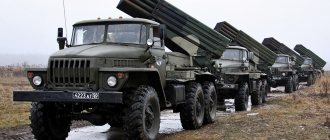| S-400 "Triumph" air defense system | |
| Type: | Long and medium range anti-aircraft missile system (AAMS) |
| A country: | Russia |
| Service history | |
| Years of operation: | 2007–present |
| Production history | |
| Constructor: | NPO "Almaz" named after. A. A. Raspletina |
| Years of production: | 2007–present |
"Triumph" ( S-400 , originally - S-300PM3, air defense index - 40Р6 , according to the US and NATO classification - SA-21 Growler , literally "Growler") - Russian long- and medium-range anti-aircraft missile system, anti-aircraft missile system (SAM) of a new generation. Designed to destroy all modern and promising means of aerospace attack - reconnaissance aircraft, strategic aircraft (including stealth aircraft) and tactical aviation, tactical, operational-tactical ballistic missiles, medium-range ballistic missiles, hypersonic targets, jammers , radar patrol and guidance aircraft and others. Each air defense system provides simultaneous firing of up to 36 targets with up to 72 missiles aimed at them.
On April 28, 2007, by decree of the Government of the Russian Federation, the Triumph was put into service.
Description
The complex can hit aerodynamic targets at a distance of up to 400 km and tactical ballistic targets flying at a speed of up to 4.8 km/s up to 60 km: cruise missiles, tactical and strategic aircraft (including those manufactured using stealth technology), ballistic missile warheads. In this case, target detection is possible at a distance of up to 600 km. The missiles can hit low-flying targets at an altitude of 5 m (for comparison: the American Patriot complex is capable of hitting targets only at an altitude of at least 60 m).
According to the Air Force Commander-in-Chief, “they are capable of effectively repelling massive raids by modern air attack weapons in conditions of intense electronic suppression and carrying out combat missions in various weather conditions.”
It is possible to use several types of missiles with different launch masses and launch ranges, which makes it possible to create a layered defense.
The control equipment includes a digital control system of the Elbrus-90micro series.
In the future, it may become the basis for a missile defense system.
The lead developer is NPO Almaz named after. Academician A. A. Raspletin. General designer - Alexander Lemansky.
| Main characteristics of Triumph | |
| Maximum speed of targets hit, km/s | 4,8 |
| Target detection range, km | 600 |
Range of destruction of an aerodynamic target, km
| 400 2 |
Target engagement altitude, km
| 30 0,005 |
Hitting range of tactical ballistic targets, km
| 60 7 |
| Number of simultaneously fired targets (full complement of air defense systems) | 36 |
| Number of simultaneously guided missiles (full complement of air defense systems) | 72 |
| Time to deploy the system from the traveling state, min | 5-10 |
| Time to bring system assets into combat readiness from a deployed state, min | 3 |
| Operating time of system assets before major overhaul, h | 10 000 |
Operational service life, years
| at least 20 15 |
- Types of goals
strategic aviation aircraft type B-1B, FB-111, B-52 specialized electronic warfare aircraft type EF-111A, EA-6 early warning aircraft type E-3A, E-2C aircraft manufactured using stealth technology type B-2 , F-117A reconnaissance aircraft, and tactical aviation cruise missiles, operational-tactical ballistic missiles (with a launch range of up to 3500 km), medium-range ballistic missiles, aeroballistic
- maximum radial speed of targets is 4.8 km/sec, target speed limit is 5 km/sec, minimum is zero.
Composition of the 40Р6 (S-400) system
- Controls 30K6E : combat control point 55K6E on the Ural-532301 chassis;
- Multifunctional control radar with phased array 92N2E (illumination range 400 km). The radar is capable of operating during active jamming.
- Launchers 5P85TE2 and/or 5P85SE2 on a semi-trailer in conjunction with a BAZ-64022 truck tractor or on a MAZ-543M chassis (up to 12 pieces; each with 4 missiles)
- Anti-aircraft missiles 48N6E , 48N6E2 , 48N6E3 of the existing S-300PM-1, S-300PM-2 air defense systems, 48N6DM , as well as promising 9M96E and 9M96E2 40N6E ultra-long-range missile .
- all-altitude radar 96L6E ; capable of working continuously, the assigned resource is 20 years or 25-30 thousand hours;
Possible elements of the S-400 (98ZH6E): 15I6ME - for communication with 98ZH6E at a distance of 30/60/90 km from 30K6E. 96L6E - a universal all-altitude three-coordinate complex, detection range of 300 km, for independent or joint combat work. 40B6M - universal tower for radar post 92N6E or 96L6E, up to 2 for 1 radar to reduce deployment time. Special anti-stealth radars: Enemy - GE, Gamma - DE. Orion is a passive sensor (locator) for target designation of air defense systems (coordinates 1 of 3), Avtobaza - M passive sensor (locator) for target designation of air defense systems (coordinates 2 of the remaining 3) and strengthening jamming stations covering troop positioning areas. 1RL220VE is a secret electronic reconnaissance system, presumably previous versions were used for electronic warfare as part of passive locators. It is possible to use missiles of the S-200D “Dubna” complex (including on standard S-400 launchers).
The 30K6E control system can control:
- S-400 Triumph 98ZK6E system;
- S-300PMU2 (via the 83K6E2 control system);
- S-300PMU1 (via the 83K6E control system);
- Tor-M1 via Ranzhir-M Command Post;
- Pantsir-S1 through the control panel of the Pantsir complex;
S-400 elements, using the 30K6E control system, and receiving information from the additional integrated 92N6E (radar);
The system consists of radar 96D6K and KP 30K6E, Opponent - GE , Gamma - DE . Accepts 92H6E radar (if added). It can be collectively combined as an element with any other complexes through the CP:
- Baikal - To a higher command post and similar;
- nearby 30K6E (S-400), 83K6E and 83K6E2 control systems (S-300);
- Polyana - V4K1 command post (Buk);
- Air Force command posts.
A complete set of S-400 can contain up to 288 missiles (6 air defense systems × 12 launchers × 4 missiles (1 in 1 container, possibly up to 4, shorter range)).
Rockets
A special order of the President of the Russian Federation revealed five indices of anti-aircraft missiles that the S-400 air defense system can launch - 48N6E, 48N6E2, 48N6EZ, 9M96E2, 40N6E.
| Rockets | |||||||||||
| GRAU index | Year | Range, km | Heights, km | Engine operating time, s | Max — low speed, m/s | Speed of targets hit, m/s | Length, m | Diameter, mm | Weight, kg | Weight of warhead, kg | Control |
| 48Н6E/ 48Н6 | 1992 | 150 | 12 | until 2100 | 7,5 | 519 | 1800 — 1900 | 143—145 | Semi-active radar homing with radio correction | ||
| 48Н6E2/ 48Н6М | 1992 | 200 | until 2100 | 2800 | 7,5 | 519 | 1800 — 1900 | 150 | Semi-active radar homing with radio correction | ||
| 48Н6E3/ 48Н6-2/ 48Н6ДМ | ? | 250 | up to 2500 | up to 4800 | 7,5 | 519 | 1800 — 1900 | 180 | Semi-active radar homing with radio correction | ||
| 9M96E2 / 9M96M non-export | 1999 | 120/1-135 | 0,005-30/0,005-35 | 1000 | 240 | 420 | 24 | Active radar homing | |||
| 9M96E | 40 | 20 | 333 | Active radar homing | |||||||
| 40N6E | 2008 | up to 400 | 185 | Active/semi-active homing | |||||||
The 9M96M missile, when launching one missile, provides a probability of intercepting a tactical aircraft - 0.9, and a UAV - 0.8. It can maneuver with an overload of 20 G at an altitude of up to 35 km, which significantly increases the ability to intercept medium and short-range ballistic missiles.
Conditions for guaranteed destruction of a missile warhead
As we have already said, one of the conditions for successfully destroying a warhead is a direct hit on it. One can understand that this may not be performed very often. Therefore, the main method is a controlled and remotely initiated (according to scanning data from the complex’s missile warhead) release of fragments. The S-400 complex, the characteristics of which we present below, provides a targeted peripheral detonation of an enemy missile.
If the system for jamming an enemy target is too successful, then the centralized detonation of the missile is activated, resulting in a symmetrical cloud of fragments rushing towards the target.
Deployment
On August 6, 2007, in Elektrostal near Moscow, the first division, equipped with the S-400 Triumph anti-aircraft missile system, went on combat duty. In 2009, a second division was added to it, which together with the first formed the 606th Guards Anti-Aircraft Missile Regiment (16 launchers in total).
On May 16, 2011, the second regiment equipped with the S-400 air defense system, the 210th anti-aircraft missile regiment in Dmitrov (2 divisions, each with 8 launchers), took up duty.
On June 8, 2012, at the Kapustin Yar test site, the next regimental set of S-400 air defense systems (2 divisions of 8 launchers each) was transferred to the troops of the Eastern Military District. Presumably the complex will be based in Nakhodka.
As of January 29, 2014, only 5 S-400 regiments were formed: in the Moscow region, in the Baltic and Pacific fleets and in the Southern Military District. Each regiment includes two S-400 divisions with eight launchers each.
Meanwhile, back on December 26, 2013, the press service of JSC Almaz-Antey announced the entry into service of two more regimental sets (4 divisions) of the S-400.
6 regiments/12 divisions/96 PU in 2014 located:
- 2 divisions in Elektrostal
- 2 divisions in Dmitrov
- 2 divisions in Zvenigorod
- 2 divisions in Nakhodka
- 2 divisions in the Kaliningrad region
- 2 divisions in Novorossiysk.
regiment (all 6) - includes 2 S-400 divisions with 8 launchers
In total, 56 divisions are planned to be acquired by 2022; for the defense of Moscow up to four S-400 regiments by 2022. Starting from 2014, the Russian Armed Forces will receive two or three regimental sets of S-400 anti-aircraft missile systems per year at an increasing rate. Provision is made for the purchase of 28 regimental sets of S-400.
Advantages over existing samples
The S-400 air defense system was developed on the basis of the S-300, but has much better characteristics in all areas. The new complex is not only cheaper, but also 2.5 times more efficient.
The uniqueness of Triumph is that the complex can work not only with new missiles that were specially developed for it, but also with old models that were produced for the S-300 and the like. Even in the basic version, the complex is equipped with four missile options at once. If deployed, it allows you to quickly organize several echelons of air defense and organize an attack on enemy air reconnaissance bases.
Thus differing from previous models, the S-400 is almost completely automated, which can significantly reduce the number of personnel required for its maintenance and repair. Thanks to the highest degree of integration with other air defense systems and MLRS, it can be used in any unit of the Russian Armed Forces.
Project evaluation
According to a study by the Australian think tank Air Power Australia, published in February 2009, the S-400 has no analogues in the world and is significantly superior to the American Patriot air defense systems.
In August 2011, Interfax noted, citing Air Force Commander-in-Chief Colonel General Alexander Zelin, that there were problems with the long-range missile. Journalists from Moskovsky Komsomolets wrote about this same year, citing their sources.
On June 28, 2012, the Chief of Staff of the Air Defense and Missile Defense Command of the Aerospace Defense Forces of the Russian Federation, Major General Andrei Demin, announced that the new long-range missile for the S-400 anti-aircraft missile systems has already been tested and will soon enter service with the troops.
Destruction of a warhead
The main requirement of a modern air defense system is not just to shoot down a missile, but to achieve guaranteed destruction of its warhead. This is especially true if the system is located in close proximity to the object it protects. It is extremely undesirable if a shot down missile falls on him, when the explosive or nuclear warhead is completely preserved in its body.
Only in the case when the warhead is intercepted while the enemy missile is approaching the target can such an unfavorable scenario be excluded. The destruction of the most dangerous parts of enemy equipment can be achieved only in two cases: either with a direct hit on the warhead, or with a sufficiently compact impact of fragments on it.



